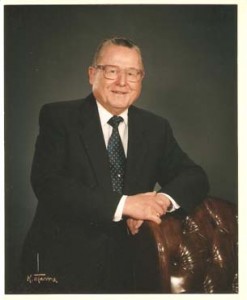By Kate Helm
In the 1960s, Gerald P. Bodey ’56 almost became a medical missionary. At that time the draft was still in place for doctors, so his physician friend, Charles Mengel ’53, suggested Bodey fulfill his draft requirements by applying for a position as a clinical associate in the leukemia service at the National Cancer Institute, National Institutes of Health, Bethesda, Md.

Gerald Bodey ’56
Excellent advice. Since, as a result, Bodey spent three years working under internationally renowned physician Emil Freireich, known as the “father of clinical cancer research” who helped discover the cure for childhood leukemia. As a specialist in infectious disease, Bodey was involved in this work as well. The rest is history.
Bodey followed Freireich to the University of Texas M.D. Anderson Cancer Center (MDACC) in 1966, where he remained until he retired in 2004. During that time, he built an impressive résumé of contributions to the field of cancer research. Recently, the Annals of Internal Medicine named a paper he co-authored in 1966 with Freireich, Monica Buckley, and Y.S. Sathe as one of three most important infectious diseases studies ever published in the journal. Entitled “Quantitative Relationships Between Circulating Leukocytes and Infection in Patients with Acute Leukemia,” it discusses neutrophils, white blood cells that fight infection, which at the time was the major fatal complication of acute leukemia.
Bodey is mentioned in James S. Olson’s book, Making Cancer History: Disease & Discovery at The University of MD Anderson Cancer Center, about finding a cure for childhood leukemia.
Nevertheless, Bodey remains modest about his achievements. “This study helped to improve the management of infections in leukemic patients,” he says. “Some of my greatest rewards were when severely ill patients achieved a remission of their cancer. An early case was an 11-year-old girl with acute leukemia. Dr. Freireich developed a new four-drug regimen, and the patient achieved remission and lived to her mid-50s when she died of breast cancer. This was the first treatment that cured children with leukemia and led to further advances.”
MDACC appointed Bodey its first chief of the section of infectious diseases in 1975. As chief of chemotherapy in the department of developmental therapeutics from 1975 to 1983, he supervised studies of more than 30 new anti-tumor agents, resulting in 275 publications. Among his most cherished roles at the cancer center were head of the adult acute leukemia service and director of new cancer drug studies.
“I came to MDACC to be involved in treating patients with acute leukemia,” he says. “It was very interesting and important to be involved in studies to identify more effective treatments for malignancies. I had always been interested in ways of improving treatment for infections in cancer patients, so I was pleased to be put in charge at our hospital.”
Bodey also holds the title of emeritus professor of medicine at the university. He delivered invited lectures at medical schools, hospitals, and scientific meetings in all 50 states and nearly 40 countries around the world. He is the author or co-author of more than 1,100 peer-reviewed papers, textbook chapters, and teaching aides, making him one of the 300 most-cited authors in scientific literature.
Among his more than 40 honors and awards from national and international organizations are the Service to Mankind Award from the Leukemia & Lymphoma Society of America and listings in 200 Most Outstanding Scientists of the 20th and 21st Centuries. Named awards at MDACC include the Gerald P. Bodey Immunocompromised Host Fellowship Training Award, Gerald P. Bodey Sr. Distinguished Professorship, and Gerald P. Bodey Award for Excellence in Education, Division of Medical Oncology.
Bodey is a Fellow of American College of Physicians, American College of Clinical Pharmacology, and Infectious Diseases Society of America, and has served on the editorial board of more than 15 medical journals including Antimicrobial Agents & Chemotherapy, Primary Care and Cancer, and Infectious Disease Review.
NASA even put Bodey on standby in 1970 when the Apollo 13 mission raised concern that astronauts may acquire a communicable disease from the lunar surface. In the event of exposure, Bodey was to be in charge of laminar airflow isolation units that reverse air flow to prevent the spread of dangerous organisms from the astronauts to the outside world. Of course, the astronauts of Apollo 13 never had contact with the moon, thus rendering the isolation units unnecessary.
Lafayette holds a special place in Bodey’s life. His foundation as a chemistry major allowed him to succeed in medical school at Johns Hopkins University where he earned his M.D. in 1960. Since his family couldn’t afford for him to live on campus, Bodey, originally of Bethlehem, Pa., remembers hitchhiking rides home on Route 22 or sleeping on the floor of a friend’s dorm room. His professor of Greek and world literature often gave him books on loan. Both of his brothers are also alumni: Richard Bodey ’52 and Phillip Bodey ’62. He married his wife, Nancy, in Colton Chapel the year he graduated.
At Lafayette, Bodey received the American Chemical Society Prize, Award of American Institute of Chemists, Merck Chemistry Prize, and Robert B. Youngman Greek Prize. He was inducted into Phi Beta Kappa and was one of two graduates with the highest grade point average at commencement.
Bodey still holds office hours one day a week at MDACC. His desire to be a missionary influenced him throughout his career, which he considers a service to a greater good. While a summary of his accomplishments could span volumes, Bodey very succinctly encapsulates his contributions.
“I’m a conservative Christian who is grateful to God for the opportunities to serve him through trying to help patients with cancer.”
